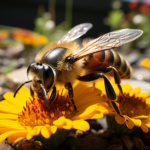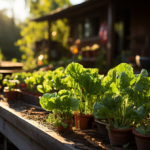Table of Contents
Transform Your Outdoor Space with an English Style Flower Garden: A Step-by-Step Guide
Hey there, green thumbs and flower enthusiasts! Are you ready to bring a touch of English charm to your outdoor oasis? Look no further because we’ve got you covered with our step-by-step guide to creating an exquisite English style flower garden.
Imagine strolling through a picturesque garden, filled with vibrant and fragrant blooms, meticulously arranged in a classic English fashion. With every turn, you’re greeted by the enchanting scent of roses, the whimsical dance of delphiniums, and the delicate elegance of lavender. Sounds like a dream, right?
Well, dream no more! With a little planning, some basic gardening know-how, and a dash of creativity, you can transform your own backyard into a little slice of England. Whether you have a spacious yard or a small balcony, there’s always room to create your own floral paradise.
In this guide, we’ll take you through each step, from selecting the perfect flowers and planning your garden layout, to nurturing and maintaining your blooming beauties. No green thumb? No problem! We’ll simplify everything, breaking it down into easy-to-follow instructions, so you can enjoy the process and watch your garden thrive.
So, grab your gardening gloves, put on your sunhat, and get ready for some hands-on, muddy fun. Let’s dive into the world of English style flower gardening and create a vibrant haven that’ll be the envy of the neighborhood. Let’s begin!
Step-by-Step Guide to Creating an English Style Flower Garden
Choosing the Right Location
- Assessing sunlight and shade patterns
- Considering soil quality and drainage
- Selecting an area with enough space for your desired garden size
- Checking for any potential obstacles or hazards
When it comes to creating an English style flower garden, location is everything. Start by observing the sunlight and shade patterns in your yard. Most English style gardens thrive in areas with ample sunlight, but a little shade can also be beneficial for certain blooms.
Next, have a look at the soil quality and drainage. English style gardens generally prefer well-draining soil that is rich in organic matter. If your soil tends to be heavy or clay-based, consider adding compost or other organic materials to improve its texture and nutrient content.
Additionally, choose an area that provides enough space for your desired garden size. Whether you have a large yard or a small balcony, you can still create a stunning English style garden. Even a few containers or raised beds can be transformed into a floral paradise.
Lastly, check for any potential obstacles or hazards that might hinder your garden’s growth. Take note of nearby trees or structures that could cast too much shade, as well as any underground utility lines that you need to be mindful of when digging.
Finding the right location is crucial for a successful English style flower garden. Take your time to evaluate your options and choose a spot that ticks all the boxes for optimal growth and visual appeal.
Stay tuned for the next installment, where we’ll delve into selecting the perfect flowers and plants for your English style garden!
Selecting the Perfect Flowers and Plants
To create an authentic English style flower garden, it’s important to choose the right flowers and plants. Start by researching traditional English garden flowers such as roses, peonies, lavender, delphiniums, and foxgloves. These timeless classics will add elegance and charm to your garden.
Consider selecting a color palette that reflects the traditional English style. Soft pastels like blush pinks, powder blues, and creamy whites are commonly seen in English gardens, but don’t be afraid to infuse pops of vibrant colors for added interest.
Varying the types of flowers you incorporate will add depth and visual appeal to your garden. Mix tall spires of delphiniums with cascading roses and mound-forming plants like lavender for an attractive layered effect. Be sure to include some filler plants such as geraniums or campanulas to add texture and fill any gaps.
Another aspect to keep in mind is the bloom times of the flowers you select. Aim for a combination of early, mid, and late-season bloomers to ensure year-round beauty in your garden. This way, you’ll have a continuous display of color and fragrance, no matter the time of year.
Remember, don’t be afraid to get creative and put your own spin on the traditional English style. Whether you prefer cottage-inspired informal designs or more symmetrical and formal arrangements, the possibilities are endless.
Planning Your English Style Flower Garden
- Taking measurements and sketching your garden layout
- Creating paths and borders for a defined structure
- Considering focal points and garden structures
- Balancing aesthetics and functionality
Planning your English style flower garden is an exciting and essential step towards creating a beautiful and organized outdoor space. To begin, take measurements of your garden area and sketch out a layout that includes key features like paths, borders, and focal points.
Creating paths not only adds structure to your garden but also provides a way to navigate through the space. Consider using materials like gravel, stepping stones, or brick pavers to define your pathways. These can be as simple or intricate as you prefer, adding a touch of elegance to your garden.
Borders play a crucial role in an English style garden, providing definition and separation between different planting areas. They can be created using low hedges, border edging, or even a combination of taller flowers. Experiment with materials like stones, bricks, or shrubs to achieve the desired effect.
When planning your garden, think about adding focal points or structures, such as a trellis, arbor, or statue. These features draw the eye and create interest within your garden. They can be adorned with climbing roses or other flowering vines to further enhance the English garden ambiance.
While aesthetics are important, don’t forget to balance them with functionality. Consider the practical aspects of your garden, such as easy maintenance, access to watering sources, and ensuring enough space for plants to grow and thrive.
By taking the time to plan your English style flower garden, you’ll be able to create a well-organized space that showcases your desired look while maintaining functionality.
Stay tuned for the next installment, where we’ll guide you through the process of preparing the soil and planting your gorgeous flowers!
Selecting the Perfect Flowers for an English Garden
- Considering the climate and hardiness zone
- Researching traditional English garden flowers
- Choosing a mix of annuals, perennials, and biennials
- Prioritizing fragrance and color
Creating an English garden is all about selecting the perfect flowers that capture the essence of that timeless, romantic charm. Here are some key points to consider when choosing the ideal flowers for your English garden:
1. Consider the climate and hardiness zone: Take into account the specific climate and hardiness zone of your area. Some flowers may thrive in certain regions while struggling in others. Choose varieties that are well-suited to your climate to ensure they will flourish in your garden.
2. Research traditional English garden flowers: Look into traditional English garden flowers to get inspiration and ideas. Roses, peonies, delphiniums, foxgloves, and lavender are all popular choices that can lend classic beauty to your garden. Other flowers such as sweet peas, hollyhocks, and violas can also be wonderful additions.
3. Choose a mix of annuals, perennials, and biennials: Combine different types of flowers to create a diverse and ever-changing landscape. Annuals will provide vibrant colors and continuous blooms throughout the season, while perennials and biennials offer structure and longevity to your garden.
4. Prioritize fragrance and color: English gardens are known for their intoxicating scents and harmonious color palettes. Select flowers that not only look beautiful but also emit delightful aromas, like roses or sweet peas. Consider a soft and romantic color scheme with pastels, whites, and pinks, complemented by bursts of vibrant hues.
Remember to take into account the specific growing requirements of each flower, such as soil type, sunlight, and watering needs. With careful consideration, you can curate a stunning collection of flowers that will transport you to a tranquil English garden right in your own backyard.
Stay tuned for the next installment, where we’ll guide you through the process of preparing the soil and planting your beautiful English garden!
Designing the Layout of Your Garden
- Considering the overall style and theme
- Creating garden “rooms” or sections
- Using layers and varying heights
- Incorporating seating areas and focal points
Designing the layout of your English style flower garden is an exciting opportunity to showcase your creativity and create a space that reflects your personal taste. Here are some key aspects to consider when designing your garden layout:
1. Consider the overall style and theme: Determine the style and theme you want to achieve with your garden. Whether it’s a formal, symmetrical design or a relaxed cottage-style garden, having a clear vision will guide your layout decisions.
2. Create garden “rooms” or sections: Divide your garden into different “rooms” or sections to create visual interest and a sense of discovery. These areas can be demarcated by hedges, trellises, or pathways. Consider having a sitting area, a flower bed, a herb garden, or a focal point like a fountain or a statue as separate sections.
3. Use layers and varying heights: Create depth and visual appeal by incorporating layers of foliage and flowers. Use taller plants, like delphiniums and hollyhocks, towards the back, and shorter ones, like roses and geraniums, towards the front. This arrangement adds dimension and texture to your garden.
4. Incorporate seating areas and focal points: To fully enjoy your English garden, incorporate seating areas where you can relax and soak in the beauty of your surroundings. Add benches, bistro sets, or a cozy swing. Integrate focal points, such as a towering obelisk covered in climbing roses, or a birdbath surrounded by lavender, to draw the eye and create a sense of enchantment.
Remember to balance aesthetics with functionality. Ensure there is enough space to move around comfortably, and consider the maintenance requirements of each section. With careful planning and attention to detail, you can create a layout that brings your English garden dreams to life.
Stay tuned for the next installment, where we’ll guide you through the process of soil preparation and planting in your English style flower garden!
Preparing the Soil for Planting
- Removing weeds and debris
- Testing and amending the soil
- Adding organic matter for improved fertility
- Ensuring proper drainage
Before planting your beautiful English style flower garden, it’s important to prepare the soil to provide the best conditions for your plants to thrive. Here are some essential steps to follow:
1. Removing weeds and debris: Start by clearing the area of any weeds, rocks, or debris. Pull out weeds by the roots to prevent them from regrowing and competing with your flowers for nutrients and water.
2. Testing and amending the soil: Test the soil to assess its pH level and nutrient content. You can purchase a soil testing kit from a garden center or send a sample to a local agricultural extension service for analysis. Based on the results, you may need to amend the soil by adding nutrients like fertilizer or lime to adjust the pH level.
3. Adding organic matter for improved fertility: Enhance the soil’s fertility by adding organic matter such as compost, well-rotted manure, or leaf mold. This improves soil structure, promotes healthy root growth, and increases moisture retention.
4. Ensuring proper drainage: Good drainage is crucial for the health of your plants. If the soil is heavy or has poor drainage, consider incorporating drainage measures such as raised beds or incorporating sand or gravel into the soil.
Once you have prepared the soil, ensure it is well-dug and crumbly. Rake the surface to create a smooth and even bed for planting.
Remember, each type of flower may have specific soil requirements, so be sure to research the needs of the plants you have chosen. By taking the time to prepare the soil properly, you provide a solid foundation for your English style flower garden to flourish.
Stay tuned for the next installment, where we’ll guide you through the process of planting your chosen flowers and bringing your English style garden to life!
No products found.
Planting and Arranging Your Flowers
- Creating a planting plan
- Digging proper planting holes
- Placing taller plants at the back and shorter ones at the front
- Grouping flowers in clusters for impact
- Considering color combinations and complementary blooms
Now that you have prepared the soil, it’s time to bring your English style flower garden to life by planting and arranging your flowers. Here are some essential steps to follow:
1. Creating a planting plan: Start by creating a planting plan, considering the layout of your garden and the specific requirements of each flower. Take into account factors like height, color, and blooming periods to ensure a harmonious and visually appealing arrangement.
2. Digging proper planting holes: Dig proper planting holes for each flower, making sure they are wide and deep enough to accommodate the plant’s root ball. Gently loosen the root ball before placing the plant in the hole and backfill with soil.
3. Placing taller plants at the back and shorter ones at the front: Position taller plants towards the back or center of flower beds, and shorter ones towards the front. This creates a natural progression of height and ensures that every flower is visible and gets adequate sunlight.
4. Grouping flowers in clusters for impact: Instead of scattering individual flowers across the garden, group them in clusters of the same variety or complementary colors. This creates visual impact and makes a stronger statement.
5. Considering color combinations and complementary blooms: Pay attention to color combinations and choose flowers that complement one another. Aim for a balanced mix of hues while keeping the overall color scheme of your garden in mind. Consider incorporating flowers that will bloom at different times to ensure a continued display of color throughout the season.
Once your flowers are planted, water them well and provide any necessary support like stakes or trellises for climbing plants. Regularly check for proper watering and provide additional care as needed.
By following these steps and using your creativity, you can achieve a stunning arrangement of flowers in your English style garden. Enjoy the process and watch as your garden transforms into a vibrant and enchanting space.
Stay tuned for the final installment, where we’ll guide you on how to care for and maintain your English style flower garden for long-lasting beauty!
Caring for Your English Style Flower Garden
- Regularly watering your plants
- Mulching to retain moisture and suppress weeds
- Deadheading spent flowers for continued blooming
- Pruning and trimming to maintain shape and encourage growth
- Monitoring for pests and diseases
Caring for your English style flower garden is essential to ensure its health, beauty, and longevity. Here are some essential tips to help you care for your garden:
1. Regularly watering your plants: Proper watering is crucial to keep your plants hydrated and healthy. Water your garden regularly, especially during dry spells, making sure to water deeply to encourage deep root growth. Avoid overwatering, as it can lead to root rot or disease.
2. Mulching to retain moisture and suppress weeds: Apply a layer of organic mulch around your plants to retain moisture in the soil, regulate soil temperature, and suppress weed growth. Mulching also adds a neat and finished look to your garden beds.
3. Deadheading spent flowers for continued blooming: Remove spent flowers by deadheading them to promote continuous bloom and prevent the plant from expending energy on seed production. This practice encourages the plant to focus its resources on producing new flowers.
4. Pruning and trimming to maintain shape and encourage growth: Regularly prune and trim your plants to maintain their shape and encourage healthy growth. Remove any dead, damaged, or diseased branches or stems. It’s also beneficial to prune certain plants during specific times of the year for optimal growth and flowering.
5. Monitoring for pests and diseases: Keep a watchful eye on your plants for any signs of pests or diseases. Early detection is key to addressing and treating any issues promptly. Regularly inspect your plants, checking the leaves, stems, and flowers for any abnormalities or signs of infestation.
Remember, caring for your English style flower garden is an ongoing process. Regular maintenance, attention, and love will help your garden thrive and continue to bring you joy throughout the seasons.
With these care tips, your English style flower garden will flourish and become a haven of beauty in your outdoor space! Enjoy the fruits of your labor and take pride in creating a stunning floral retreat.
No products found.
Maintaining the Health and Beauty of Your Garden
- Regularly fertilizing your plants for optimal nutrition
- Preventing and managing common garden pests and diseases
- Trimming and pruning to maintain shape and promote growth
- Dividing and transplanting as needed to prevent overcrowding
- Continuing weed control and mulching
Maintaining the health and beauty of your English style flower garden is vital to ensure it thrives and remains a stunning oasis. Here are some essential tips to help you keep your garden looking its best:
1. Regularly fertilizing your plants for optimal nutrition: Provide your plants with essential nutrients by fertilizing them regularly. Choose a slow-release fertilizer or use organic options such as compost or well-rotted manure. Follow the manufacturer’s instructions and avoid over-fertilizing, as it can harm your plants.
2. Preventing and managing common garden pests and diseases: Keep an eye out for common garden pests, such as aphids, snails, or slugs, that can damage your plants. Use organic pest control methods, like neem oil or companion planting, to deter pests. Monitor your plants for signs of diseases, such as powdery mildew or black spot, and treat them promptly to prevent further spread.
3. Trimming and pruning to maintain shape and promote growth: Regularly trim and prune your plants to maintain their shape and promote healthy growth. Remove any dead, diseased, or damaged branches to improve airflow and prevent the spread of diseases. Prune at the appropriate time for each plant to avoid interfering with blooming periods.
4. Dividing and transplanting as needed to prevent overcrowding: If your plants become overcrowded or outgrow their space, consider dividing and transplanting them to create more room. This helps improve airflow, prevents competition for resources, and revitalizes your flower beds. Follow proper division and transplantation techniques to minimize stress on the plants.
5. Continuing weed control and mulching: Stay vigilant in weed control by regularly pulling out any weeds that emerge in your garden. Utilize mulching as a preventive measure to suppress weed growth and retain moisture in the soil. Refresh the mulch layer as needed to maintain its effectiveness.
By incorporating regular maintenance practices and giving your garden the attention it needs, you can ensure the continued health and beauty of your English style flower garden. Enjoy the rewards of a well-maintained garden with blossoming flowers and a serene atmosphere.
With these maintenance tips, your English style flower garden will flourish and be a source of joy for years to come! Keep tending to your garden, and watch as it continues to evolve and captivate.
Enhancing Your Garden with Complementary Features
- Adding a charming garden bench or seating area
- Incorporating whimsical garden ornaments and decor
- Creating a focal point with a lovely garden arbor or trellis
- Introducing a soothing water feature
- Planting climbing vines to add vertical interest
To take your English style flower garden to the next level, consider enhancing it with complementary features that add charm and personality. Here are some ideas to inspire you:
1. Adding a charming garden bench or seating area: Create a cozy nook within your garden by placing a charming garden bench or setting up a small seating area. It’s the perfect spot to relax, sip a cup of tea, and enjoy the beauty of your garden up close.
2. Incorporating whimsical garden ornaments and decor: Infuse some whimsy and character into your garden by incorporating fun garden ornaments and decor. From whimsical sculptures to decorative birdhouses or wind chimes, there are plenty of options to choose from that reflect your personal style and add a touch of whimsy to your garden.
3. Creating a focal point with a lovely garden arbor or trellis: An eye-catching garden arbor or trellis can serve as a charming focal point in your garden. It not only adds visual interest but also provides support for climbing flowers and vines, such as roses or clematis. Choose a design that complements your garden’s style and allows the flowers to creep and intertwine beautifully.
4. Introducing a soothing water feature: Enhance the tranquility of your garden by introducing a soothing water feature, such as a small fountain, birdbath, or reflecting pool. The sound of trickling water adds a serene ambiance and attracts birds, enhancing the natural beauty of your garden.
5. Planting climbing vines to add vertical interest: Utilize vertical space by planting climbing vines against walls, fences, or trellises. Flowers like morning glories, jasmine, or sweet peas can add a sense of height, depth, and visual interest to your garden.
By incorporating these complementary features, your English style flower garden will be transformed into a beautiful and enchanting retreat that reflects your personal style and invites you to spend more time immersed in its beauty.
Continue to add your personal touch and unique elements to make your garden truly your own! Enjoy the magical ambiance you’ve created and let your garden be a place of inspiration and solace.
No products found.
Dealing with Common Garden Pests and Diseases
- Regularly inspecting your plants for signs of pests or diseases
- Using natural remedies and organic pest control methods
- Removing affected plant parts and disposing of them properly
- Encouraging beneficial insects and birds to control pests
- Practicing good garden hygiene and crop rotation
Keeping your English style flower garden healthy and pest-free is essential for its success. Here are some tips to help you deal with common garden pests and diseases:
1. Regularly inspecting your plants for signs of pests or diseases: Regularly inspect your plants for any signs of pests or diseases. Look for chewed leaves, holes, discoloration, wilting, or abnormal growth. Early detection is key to preventing the spread of pests or diseases and taking immediate action.
2. Using natural remedies and organic pest control methods: Utilize natural remedies and organic pest control methods to treat and prevent infestations. Examples include using insecticidal soap, neem oil, or homemade remedies like garlic spray or peppermint oil spray. These options are safe for your plants, the environment, and beneficial insects.
3. Removing affected plant parts and disposing of them properly: If you notice any signs of pests or diseases, promptly remove and dispose of affected plant parts. This helps prevent further spread and damage. Be careful not to spread any potential pathogens by cleaning your gardening tools between plants.
4. Encouraging beneficial insects and birds to control pests: Encourage beneficial insects like ladybugs, lacewings, and bees to your garden. They help naturally control pests by feeding on them. Additionally, attracting birds to your garden can help control pest populations.
5. Practicing good garden hygiene and crop rotation: Practice good garden hygiene by cleaning up fallen leaves, weeds, and debris where pests or diseases may harbor. Consider implementing crop rotation techniques, especially if you have a vegetable garden. Rotating crops helps prevent the buildup of pests and diseases that target specific plants.
By being proactive in monitoring your garden, using organic pest control methods, and practicing good garden hygiene, you can effectively manage common garden pests and diseases without resorting to harmful chemicals.
With proper care and attention, your English style flower garden will remain a healthy and vibrant sanctuary for you to enjoy. Embrace the challenges and take pride in nurturing a thriving garden!
No products found.
Enjoying and Showcasing Your English Style Flower Garden
- Creating inviting seating areas to enjoy your garden
- Hosting garden parties or social gatherings
- Snipping fresh flowers for indoor bouquets
- Participating in garden tours or open house events
- Sharing your garden’s beauty on social media
Once you’ve put in the effort to create your beautiful English style flower garden, it’s time to sit back, relax, and enjoy the fruits of your labor. Here are some ideas for showcasing and enjoying your garden:
1. Creating inviting seating areas to enjoy your garden: Set up cozy seating areas within your garden to fully experience its beauty. Place a bench under a blooming tree, add a bistro set on a patio, or create a charming nook with some comfortable chairs. Sit back, unwind, and soak in the peace and serenity of your garden.
2. Hosting garden parties or social gatherings: Share the beauty of your English garden with friends and loved ones by hosting garden parties or social gatherings. Arrange a BBQ, tea party, or even a small wedding celebration. Your garden will become a magical backdrop for memorable moments.
3. Snipping fresh flowers for indoor bouquets: Bring the enchanting beauty of your garden indoors by snipping fresh flowers for bouquets. Fill your home with the delightful fragrance and vibrant colors of your English flowers. Arrange them in vases and share their beauty throughout your living spaces.
4. Participating in garden tours or open house events: Consider participating in garden tours or open house events in your community. Share your garden’s charm and inspire others with your English style floral retreat. It’s a wonderful opportunity to connect with fellow garden enthusiasts and exchange ideas.
5. Sharing your garden’s beauty on social media: Capture and share the beauty of your garden on social media platforms. Post pictures and share stories about your gardening journey. Connect with other gardeners, get inspired by their creations, and inspire others with your own green-thumb successes.
By embracing and showcasing your English style flower garden, you not only enhance your own enjoyment but also spread joy and inspiration to others.
Take pride in what you’ve created and let your English style flower garden be a source of inspiration, relaxation, and a testament to the power of nature’s beauty. Enjoy every moment and share the love for gardening with the world!
Conclusion
Congratulations on completing the step-by-step guide to creating your very own English style flower garden! You’ve embarked on a journey filled with beauty, creativity, and connection with nature. By following the essential aspects outlined in this guide, from choosing the perfect flowers to maintaining a healthy garden, you have transformed your outdoor space into a charming oasis.
Now, take a step back and admire the beauty of your English style flower garden. Immerse yourself in the delightful colors, intoxicating scents, and serene atmosphere that your garden offers. Whether you’re enjoying moments of solitude, hosting garden parties, or sharing pictures on social media, your garden is a testament to your creativity and love for nature.
Remember, gardening is a continuous learning experience, and your English style flower garden will evolve and change over time. Embrace the challenges, learn from them, and continue to nurture and care for your garden.
Share your knowledge, tips, and successes with fellow garden enthusiasts. Inspire others to embark on their own gardening adventures, and let your English style flower garden become a source of joy and inspiration for everyone.
So, get out there and continue to grow, learn, and bask in the beauty of your very own English style flower garden. Happy gardening!









